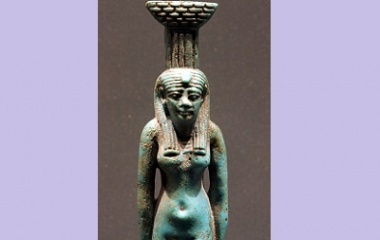- Pronunciation: nep-these
- Origin: Egypt
- Role: Protector of souls
- Symbols: Hawk, sycamore tree, mummy wrappings
Who Is Nephthys?
Nephthys was the fourth child born to the god of the earth and the goddess of the sky, making her one of the most ancient deities in Egyptian mythology. She held the astute designation of membership in the Ennead of Heliopolis, which means collection of nine. The Ennead consisted of Atum, who was the very first of the gods, and his children and grandchildren. A very powerful group of deities worshipped at the cult center of Heliopolis. Her reign as an important goddess lasted all the way through the very last Egyptian dynasty.
Nephthys is identified as the goddess of the transition of death. That sounds pretty morbid, but actually she’s a helper, watching over the mummies and comforting the families of the deceased. Her name translates to lady of the house, but don’t mistake her for a housewife – she was high priestess overseeing the temple house and the house of the heavens.
Origin
After the very first god Atum created himself, he created Geb, the god of the earth and Nut, the goddess of the sky. They had five very significant god and goddess children and grandchildren, namely, Osiris, Isis, Set, Nephthys and Horus in that order.
It was the job of Nephthys to protect the souls of the dead, and she was often called upon for funerals. There were actually people in ancient Egypt who were charged with the task of being professional mourners of the dead, and they became known as the Hawks of Nephthys. Her image even appears in the tomb of Tutankhamun, the most famous pharaoh ever, aka King Tut. She was presumably there to watch over his great soul and assist him with the transition to the afterlife.
Other special tasks of the goddess were to watch over embalmed lungs which were preserved in jars back then, and to babysit for her nephew Horus.
Not surprisingly, given the way things were among the ancient Egyptian gods, she was married to her brother, Set. He was not as nice a guy as their brother Osiris, who as the oldest became the king, and was revered throughout the world and the underworld. Osiris married their sister, Isis.
Set represented the infertile desert, leaving Nephthys childless. Desperately wanting a baby, she disguised herself as her sister, and with wine in hand went to see Osiris and seduced him into her bed. The drunken sex produced a child named Anubis, who was the god of mummies. The Egyptians used to adorn themselves with flowers, and being a bit drunk, Osiris dropped his on the way out of the tryst. This tipped off Set, who found the flowers.
One day Set’s jealousy of Osiris overwhelmed him. He wanted the respect of the people who honored his brother, revenge for the bedding of his wife, and he wanted to be the king. So Set transformed himself into a monster, murdered his brother and then cut him into pieces which were strewn about the land.
Set was now the king, and Nephthys his queen. However, Isis was devastated over the death of her husband and decided to search the land for each and every piece of his body. Nephthys felt so sorry for her sister that she assisted her on the mission. Together, they found all the body parts and put Osiris back together. The sisters used their magic to breathe life back into him which lasted just long enough for Isis to become pregnant with their son, Horus.
Osiris, still exhausted from his ordeal, descended to the underworld once again where he became the ruler. When Horus grew up, he challenged Set for the kingship as it was his right of birth, and after contests and a debate amongst the gods, Horus became the king.
Historic Influence
In addition to being the close magical counterpart of her notorious sister Isis, playing an important role in the transition of the dead to the afterlife, it is also believed that Nephthys was the protector of the sacred Bennu bird. The Bennu was worshipped in Heliopolis, considered a central figure in the myth of creation, and was associated with the sun god Ra. Later in Greece, the Bennu was called a phoenix.
Nephthys is mentioned in the Book of the Dead, a document of the magic spells the Egyptians used to help them transition to the afterlife. The ancient work is preserved and on display at the Louvre in Paris.
Although she probably didn’t receive the same level of attention as her sister Isis, who presided over health, life and marriage, the legends say that Nephthys was just as beautiful, and she protected the pharaohs while they were alive and even after they were dead.










